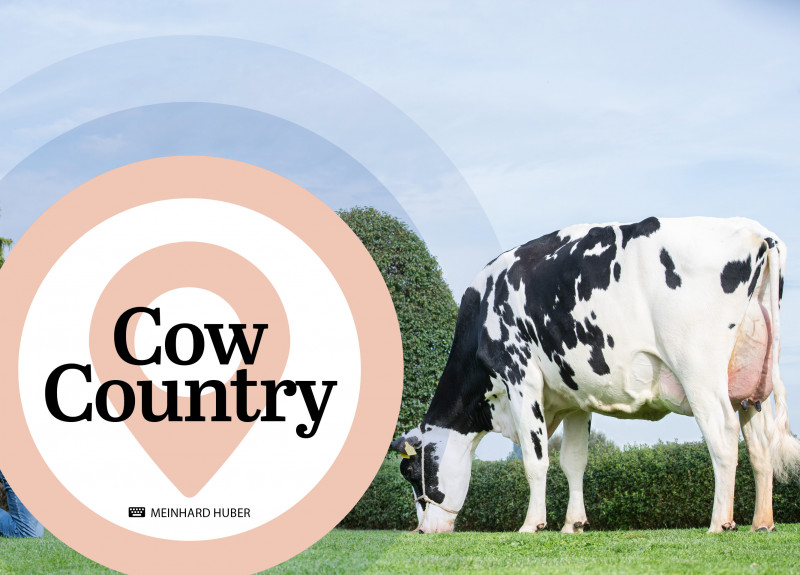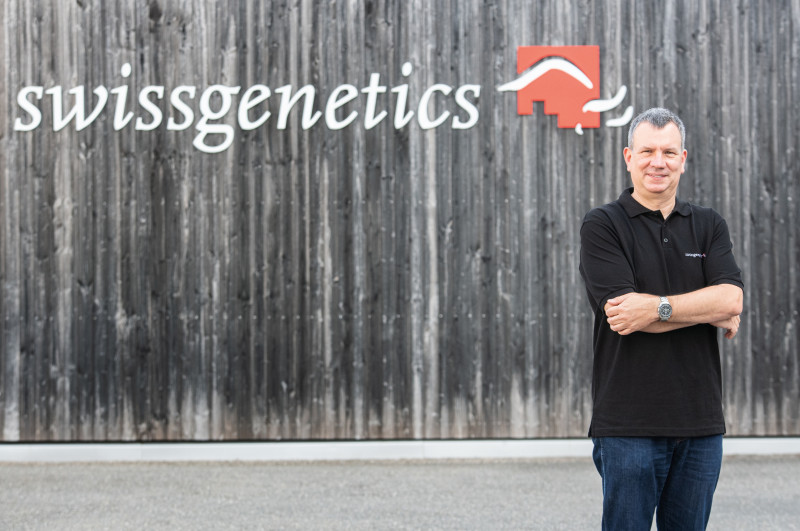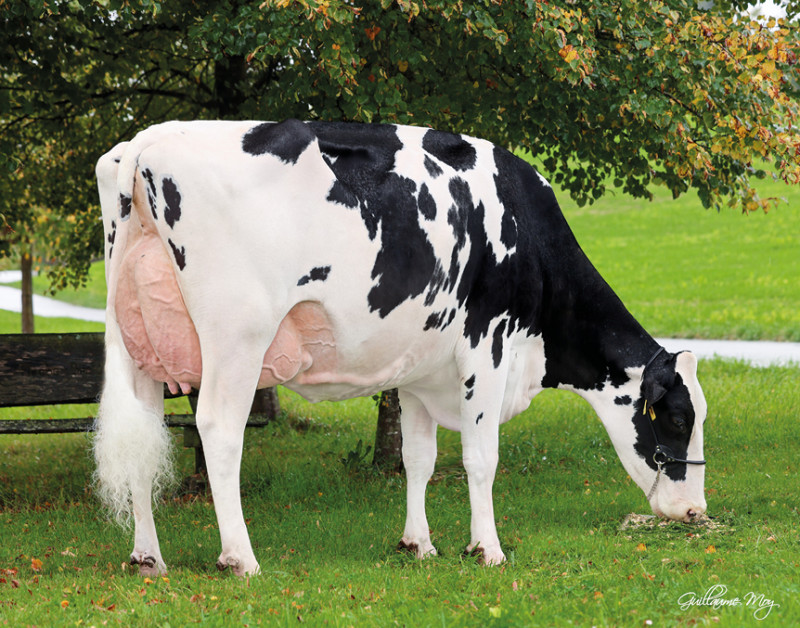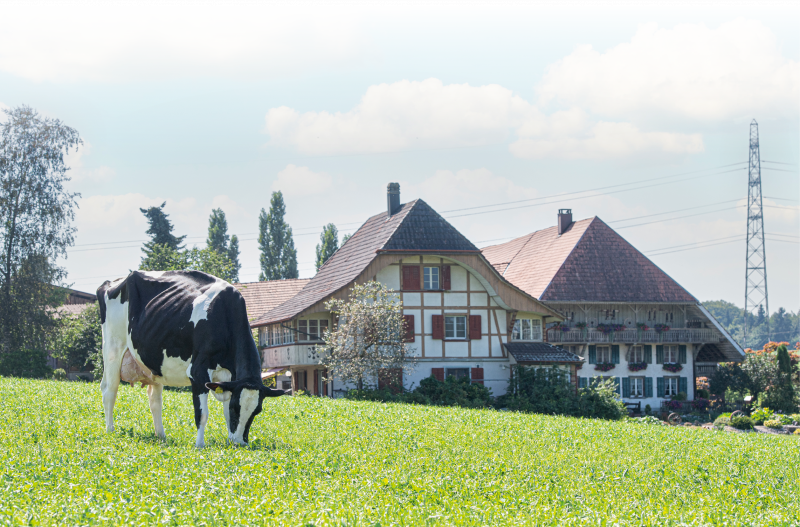
She comes from the cow family of Erbcrest Goldwyn Rosie EX-90. The high-type Wyss Randall Emma EX-90 has produced over 60,800kg in four lactations. Currently in her fifth lactation, she has a daily average of over 60kg milk.
The Holstein breeding operation of the Wyss family in the Bern canton of Switzerland looks back over a 120-year family story. It is shaped by hard work, passion for cattle breeding, impressive successes in dairy farming and Holstein breeding. The story of the family is told here, whose lifeblood is Holstein breeding and continuous improvement. With Wyss Rudolph Haiti, the farm bred the first 200,000kg (440,000lb) cow in Switzerland. She reached an age of 21 years, 8 months. Her offspring follow in her tracks and Haiti’s granddaughter Wyss Blaide Herta is on the verge of the “magical” lifetime production threshold of 200,000kg!
MEINHARD HUBER, HAN HOPMAN
Anyone who speaks with Markus Wyss immediately picks up on his passion for breeding Holsteins. Together with his wife Susanne and their children Michelle, Lukas, Laura and Steffi, they are the fourth generation on the farm. Up until 1976, Markus’s father had a herd of 20 Simmental and Red Fleckvieh cows with an average production of 5,000kg. As of 1977, the farm started cross breeding with Red Holsteins, with particularly high use of Branderlea Citation Topper-Red, explains Markus. The world-renowned Wyss Rudolph Haiti is also from such a pairing. Her granddam was Wyss-Topper Helga-Red and Haiti’s dam was a Trimbo daughter who was born in 1987 and lived to an age of 16 years, with lifetime production of over 120,000kg (264,000lb). ‘She was our first cow to reach the 100,000kg mark and that was a sensation at the time when it happened,’ Markus remembers. They began breeding with Holstein bulls in 1995. ‘At the time I did a lot of matings with Startmore Rudolph,’ Markus shares. In this way Wyss Trimbo Hassa, the dam of Haiti, was also pregnant to Rudolph. Haiti was born in April 1998 and of course no one knew at the time that she would one day be something very special. Haiti was an exceptional cow for the Wyss family, and she was the first 200,000kg (440,000lb) cow in Switzerland. She reached an age of 21 years and 8 months, was classified VG-89 and recognized with a “Gold Medal” title. Haiti had two daughters that passed on the longevity gene. Wyss Mr. Sam Hassa VG-88, who produced 100,583kg (221,283lb) in seven lactations and is the half-sister of Wyss Glen Hadela. From Hadela comes the twelve-year-old Jordan daughter Harley, who was sold in her second lactation. She is at a Swiss breeding colleague and now in her 10th lactation with a lifetime production of 121,347kg (266,963lb). From Harley there is still the Meteor daughter Herby EX-90 2E on the Wyss farm. She is currently in her eighth lactation and has produced over 116,000kg (255,200lb). From the aforementioned Mr.Sam daughter Hassa is another special cow: the Blaide daughter Herta VG-88, born in February 2009 and still in the herd. The unbelievable thing about this is that Herta, with 198,208kg (436,058lb), will soon be the second home-bred 200,000kg lifetime production cow for the Wyss family. ‘This line is simply incredible. Cows that work hard every day and also stay healthy. It is moments like these that bring emotion and passion for our daily work,’ says Markus.
‘One of my biggest successes: To have a family that shares my passion for Holstein breeding!’
IMPROVEMENT
‘We like participating in regional shows and everybody helps out. Nonetheless, the main goal on our farm is milk production. It is important that a cow is robust, can produce a lot of milk, and if she looks good on top of that, so much the better,’ Markus explains. There is a constant effort to improve the herd for production, functionality, and conformation. ‘When my wife Susanne and I took over the farm from my parents in 1996, we delivered 80,000kg milk to the cheese factory in the village; today that number is between 600-700,000kg.’ In 2005 they built a new free-stall barn and since 2021 they have a Lely milking robot. Since this point in time, it has been very important to add other traits for consideration in sire selection, the family tells me. Udder depth, teat placement and teat shape (length and thickness) receive more attention. ‘Further to those, rear leg angle is a very important criterion for us. In the last four years we had more and more heifers with rear legs that were too straight. Sometimes it was so bad that we had to cull them,’ Markus tells me. Additionally, no bull gets into the semen tank with a milk value of less than 1,000kg, negative fat and protein or fitness values. For some time, the matings have been looked after by their daughter Michelle and son Lukas. Right now, there are an increasing number of polled bulls on their semen list. 35% of the herd is heterozygous and 5% is homozygous polled. ‘When we are very happy with fresh animals from a bull, we use him again as sexed semen,’ Markus shares. In recent times there were bulls like A2P2 and Letsgo that convinced with robust, high-producing young cows in the herd and brought the Wyss family a lot of joy. ‘For us it is important that the heifers have an early age at first calving, between 20-22 months,’ the family feels. At the moment, 50% of the herd are first lactation heifers that have calved at 21 months of age on average and produce 10,000kg milk. The second lactation animals average 13,000kg and the older cows average 16,000kg. This gives a herd average of 12,000kg at an average age of 35 months. ‘We sell 30 breeding cows every year. They are most often in the second lactation, which are still young and allows us to achieve the best price while having an ideal basis for selection.’
MASTER BREEDER
In addition to the previously mentioned “exceptional cows” there is a long list of cows that we could discuss. So far, 25 cows have been classified EX on the farm. There are two families that have three consecutive generations EX and the fourth generation just missed with a score of VG-89. Wyss Rudolph Tabea EX-90 2* was the first cow with an EX classification. Her Talent daughter Talmi was EX-92 4E and had a lifetime production of 87,000kg. From her came the third generation EX, Wyss Alexander Talya EX-91 2E. They have had 33 cows achieve breeding stars. Wyss Delco Tulpe-Red holds the lead with seven stars. To date there are 25 Gold Medal cows. One special thing is that the cow Wyss Kerrigan Rubina achieved this recognition after three lactations. That makes her the first cow in Switzerland to achieve this. In the last 30 years there were 15 cows with a lifetime production of more than 100,000kg. Special among this group is the cow Wyss Iota Bellami. She broke this mark within five lactations. In her fourth and fifth lactations she had a 305-day production of 20,800kg and her highest daily production was 81.8kg. Through selected embryo imports, fresh blood was brought into the Wyss herd. One example is the Jacobs Let-It-Snow Lindsey EX-92 4E with over 117,000kg milk. She is a direct daughter from Jacobs Goldwyn Britany EX-96. Another product of a successful ET is the pretty Wyss Randall Emma EX-90. Through a Beemer and an EX-90 Planet she goes back to Erbcrest Goldwyn Rosie EX-90. From this line the farm also sold their first bull, Wyss Eddy, to an AI stud. For many of these special achievements the Wyss family received the Master Breeder award in 2020. As you can see, the list of the many outstanding cows on the Wyss farm is long and will surely continue to grow in the future.

Wyss Holsteins in Switzerland
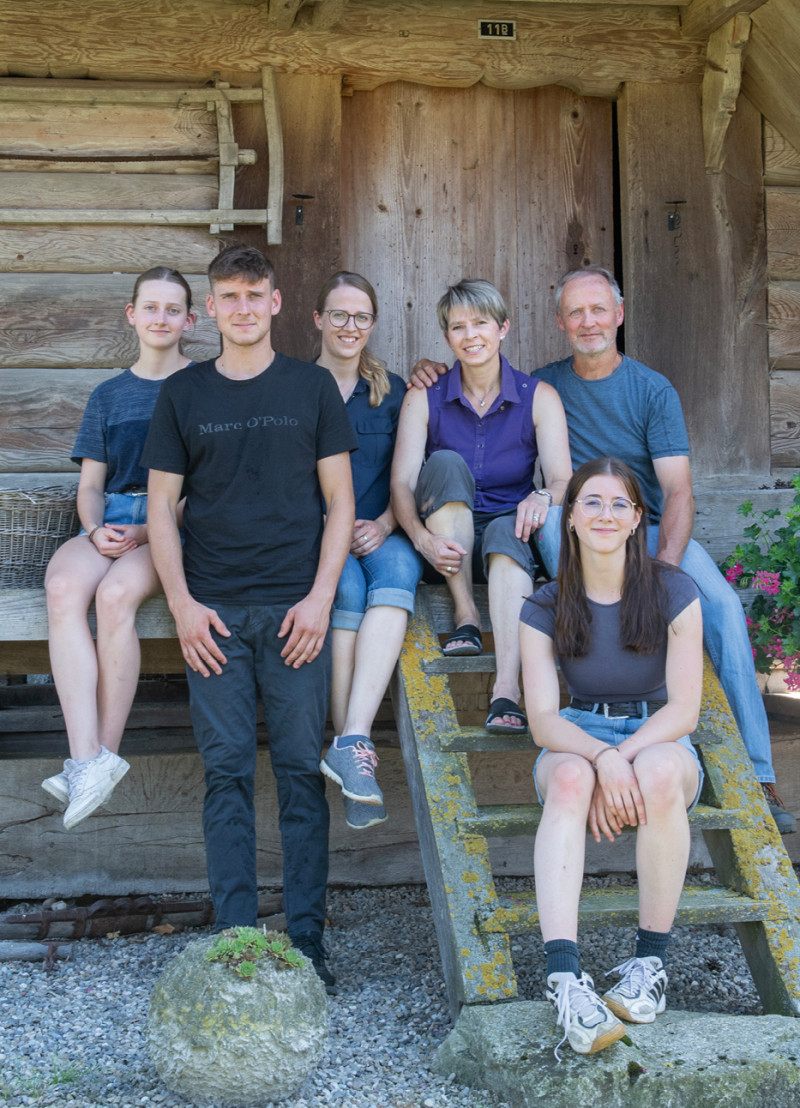
Many hardworking hands: Markus and Susanne Wyss, Michelle, Lukas, Laura and Stefanie.
Farm in Grasswil 560 m above sea level Owners: Markus and Susanne Wyss with their son Lukas 23 ha tillable land, 7 ha forest 55 dairy and breeding cows 75 heifers Feeding: silage, 1/3 Grassilage, 1/3 whole corn plant shredlage, malt, dry alfalfa, minerals and salt, 1kg rapeseed meal, 3 kg grain mix and concentrate through the robot. Pasture access: daily, the cows have free access to the pasture from the barn Production: 11,500kg (25,300lb) 3.82%F 3.43%P Current sires: Letsgo, Luster-P, Renegade, Solo-P, Blakely, Holysmokes, Cardano-PP
